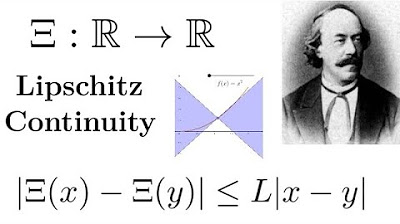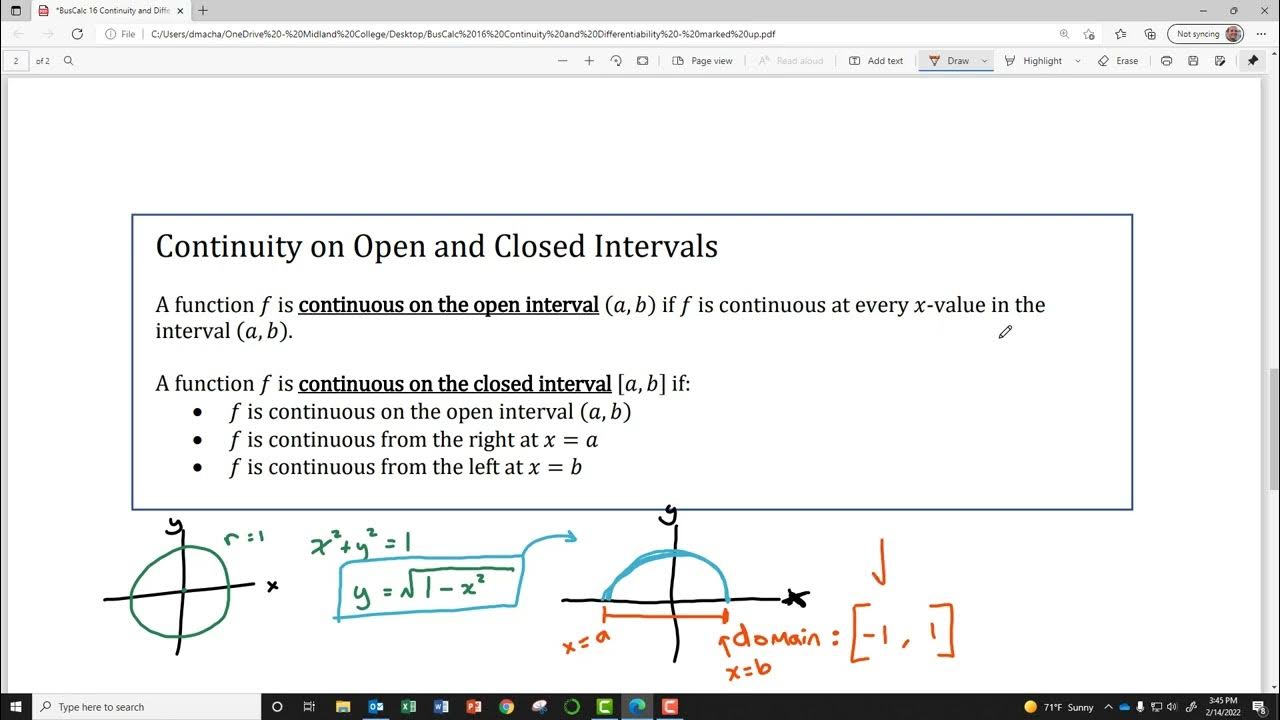Ordinary Differential Equations 9 | Lipschitz Continuity
TLDRIn this engaging video on ordinary differential equations (ODEs), the presenter delves into the concept of Lipschitz continuity, a pivotal aspect for ensuring the uniqueness of solutions to initial value problems. The video begins by differentiating Lipschitz continuity from mere continuity and continuous differentiability, highlighting its position as a 'middle ground' between the two. The formal definition of local Lipschitz continuity is then introduced, emphasizing the importance of a constant L that bounds the rate of change within a local neighborhood. The presenter further illustrates the implications of this property for the convergence of function values and the boundedness of local slopes. The video also establishes a connection between Lipschitz continuity and differentiability, particularly for continuously differentiable functions (C1). By applying the mean value theorem, it is shown that such functions are also locally Lipschitz continuous. The video concludes with a teaser for the next installment, where the presenter promises to demonstrate the uniqueness of solutions for ODEs with locally Lipschitz continuous functions, captivating the audience's interest for the continuation of the series.
Takeaways
- 📚 The video discusses the uniqueness of solutions for ordinary differential equations (ODEs) with an emphasis on Lipschitz continuity.
- 🔍 Lipschitz continuity is positioned between continuity and differentiability, offering a middle ground that is crucial for solving ODEs uniquely.
- 🌟 A function is considered locally Lipschitz continuous if there exists a constant L such that the change in the function's output is bounded by L times the change in its input, within a local neighborhood.
- 📉 If a function is locally Lipschitz continuous, it is also continuous, as the output values converge if the input values do.
- 🚫 Lipschitz continuity implies that the function's slopes are bounded and do not approach infinity within a local neighborhood.
- ➗ The difference quotient, which is used to estimate the slopes of a function, is less than or equal to the constant L for a locally Lipschitz continuous function.
- 📌 For a continuously differentiable function (C1 function), the mean value theorem can be applied to show that it is also locally Lipschitz continuous.
- 📐 The mean value theorem helps to establish that the secant slope can be represented as a tangent slope, which is a key step in proving Lipschitz continuity for differentiable functions.
- 🧮 The Lipschitz constant L can be determined as the supremum of the absolute value of the derivative of the function within an epsilon neighborhood.
- 🔢 The Lipschitz constant can be zero, but it is often chosen to be larger to ensure it satisfies the condition for all points in the neighborhood.
- 🔗 The concept of Lipschitz continuity will be applied in the next video to prove the uniqueness of solutions for initial value problems in ODEs.
Q & A
What is the main topic discussed in this video?
-The main topic discussed in this video is the uniqueness of solutions for ordinary differential equations (ODEs), with a focus on the concept of Lipschitz continuity, particularly locally Lipschitz continuous functions.
What is the significance of Lipschitz continuity in the context of ODEs?
-Lipschitz continuity is significant in the context of ODEs because it provides a middle ground between continuity and differentiability. It is a key ingredient needed to ensure that solutions to ODEs are unique.
What does it mean for a function to be locally Lipschitz continuous?
-A function is locally Lipschitz continuous if, for every point in its domain, there exists a neighborhood (an epsilon ball) such that the function's rate of change (the difference between the function's values at two points) is bounded by a constant times the distance between those points within that neighborhood.
How does Lipschitz continuity relate to the differentiability of a function?
-If a function is locally Lipschitz continuous, it implies that the function's slopes (rates of change) are bounded within a neighborhood, which in turn means that the function cannot be infinitely steep at any point. This property is closely related to differentiability, as a differentiable function with a bounded derivative is also Lipschitz continuous.
What does the mean value theorem state in the context of differentiable functions?
-The mean value theorem states that for a differentiable function on a closed interval, there exists at least one point in the interval where the derivative of the function equals the average rate of change of the function over that interval.
Why is the concept of a Lipschitz constant important?
-The Lipschitz constant is important because it provides an upper bound on the rate of change of a function within a given neighborhood. This constant is crucial for proving the uniqueness and stability of solutions to ODEs.
What is the implication of a function being continuously differentiable?
-A function that is continuously differentiable not only has derivatives at every point in its domain but also those derivatives are continuous functions. This is a stronger property than just being differentiable and implies Lipschitz continuity.
How does the script connect the concept of Lipschitz continuity to the existence of solutions for ODEs?
-The script suggests that Lipschitz continuity is a necessary condition for the uniqueness of solutions to ODEs. If the function in an ODE is locally Lipschitz continuous, it ensures that there is a unique solution to the ODE within a certain neighborhood.
What is the role of the epsilon neighborhood in defining Lipschitz continuity?
-The epsilon neighborhood is used to define a local condition for Lipschitz continuity. It ensures that the Lipschitz condition holds for all points within a small enough neighborhood around a given point in the function's domain.
Can a function be Lipschitz continuous without being differentiable?
-Yes, a function can be Lipschitz continuous without being differentiable. Lipschitz continuity is a weaker condition than differentiability, so there are functions that satisfy the former but not the latter.
What is the importance of proving that a continuously differentiable function (C1 function) is also locally Lipschitz continuous?
-Proving that a C1 function is locally Lipschitz continuous is important because it provides a broader class of functions that can be used to analyze ODEs. It also shows that the properties of differentiable functions are more general than previously thought, allowing for a wider range of applications in mathematical analysis.
How does the concept of Lipschitz continuity apply to higher dimensions?
-The concept of Lipschitz continuity applies to higher dimensions in a similar way to one dimension. It requires that the change in the function's values is bounded by a constant times the change in the input values within a neighborhood, measured using the standard norm in the higher-dimensional space.
Outlines
📘 Introduction to Lipschitz Continuity
The first paragraph introduces the concept of Lipschitz continuity, which is a property that lies between continuity and differentiability. It is described as a crucial ingredient for the uniqueness of solutions to ordinary differential equations (ODEs). The paragraph begins by thanking supporters and then delves into the definition of locally Lipschitz continuous functions. It explains that this property ensures there is a constant (referred to as the Lipschitz constant) that bounds the rate of change of the function within a local neighborhood. The importance of this property for solving ODEs is emphasized.
📚 Properties and Implications of Lipschitz Continuity
The second paragraph discusses the implications of Lipschitz continuity. It establishes that a function with this property is necessarily continuous, which is proven by showing that the convergence of input sequences implies the convergence of their images. The connection between Lipschitz continuity and differentiability is also explored. By using the mean value theorem, it is shown that the slopes of the function within a neighborhood are bounded by a constant, which is key for the analysis of ODEs. The paragraph concludes by demonstrating that a continuously differentiable function (C1 function) is also locally Lipschitz continuous.
🔍 Examples and Application to ODEs
The third paragraph provides examples of locally Lipschitz continuous functions and discusses their application to ordinary differential equations. It notes that the proof from the previous paragraph extends to higher dimensions, which will be useful in the next video. The paragraph concludes with a teaser for the upcoming discussion on the uniqueness of solutions for initial value problems where the function V is locally Lipschitz continuous, and ends with a farewell note.
Mindmap
Keywords
💡Ordinary Differential Equations (ODEs)
💡Uniqueness of Solutions
💡Lipschitz Continuity
💡Locally Lipschitz Continuous Functions
💡Continuity
💡Differentiability
💡Continuously Differentiable
💡Epsilon Ball
💡Lipschitz Constant
💡Mean Value Theorem
💡C1 Function
Highlights
The video discusses the uniqueness of solutions for ordinary differential equations (ODEs) using the concept of Lipschitz continuity.
Lipschitz continuity is a property that lies between continuity and differentiability for functions.
A function is considered locally Lipschitz continuous if it satisfies a local condition at each point in its domain.
Local Lipschitz continuity implies ordinary continuity, meaning if a function is locally Lipschitz, it is also continuous.
Local Lipschitz continuity ensures that the slopes of the function within a neighborhood do not go to infinity.
Differentiable functions, particularly C1 functions, are also locally Lipschitz continuous.
The mean value theorem is used to connect the secant slope to the derivative of a function, providing a method to estimate the Lipschitz constant.
For a differentiable function, the Lipschitz constant can be determined by the supremum of the absolute value of the derivative within an epsilon neighborhood.
The concept of Lipschitz continuity is crucial for solving ODEs in a unique way.
The video provides a formal definition of locally Lipschitz continuous functions using mathematical notation.
The importance of the Lipschitz constant L, which works uniformly for all points within an epsilon ball, is emphasized.
The video demonstrates how the properties of Lipschitz continuity can be used to prove the convergence of function images.
An epsilon neighborhood is used to establish the local nature of Lipschitz continuity.
The video explains the implications of the differentiability of a function on its Lipschitz continuity.
The concept is applicable to higher dimensions, which will be discussed in the next video.
The video concludes with the application of Lipschitz continuity to prove the uniqueness of solutions for initial value problems in ODEs.
Supporters on YouTube and Patreon are acknowledged for making the creation of such mathematical content possible.
The video ends with a teaser for the next part of the series, which will further explore the application of Lipschitz continuity to ODEs.
Transcripts
5.0 / 5 (0 votes)
Thanks for rating:





